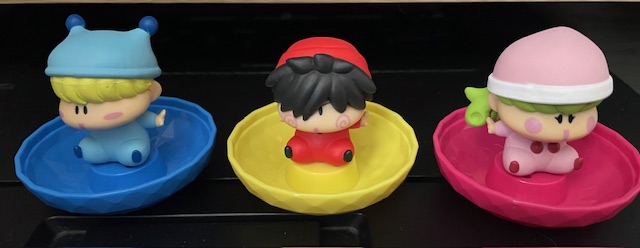
先週横浜での打ち合わせの帰りにビブレに寄ったのですが、その際にガチャガチャコーナーがあって、ここは結構世相を反映しているとおもうところでもありじっくりと見ていました。最近のキャラはもちろんのこと、食べ物のパッケージや蛇口、信号のボタン、踏切、麻雀牌、ディズニー、キン肉マン動物など多種多彩。これだけ沢山のキャラを作っていたらコストもかかりそうと思ってみていると、結構高いのです。エヴァンゲリオンのキャラは1500円。ガチャガチャの域を超えていると感じましたが、一定のニーズがあるのでしょう。
ここでほしいと思ったのは、森伊蔵とフリーレン、麻雀関連、赤ずきんチャチャ、あと写真にも乗せたミルモでポンなど。それで思わず、400円を投資してガチャを回してみたのでしたが、この手のガチャガチャは当然ながら複数の種類があり、自分の希望するキャラが出るかどうかはわかりません。失敗すれば「もう一回」となるのが運営側の目論見であるのは明白です。
クレーンゲームも同様に好奇心そそるものですが、こちらは何が手に入るかは明確であるものの、投資額に関わらず何も手に入れられないケースもあります。どちらがお得かは人それぞれですが、ガチャガチャのほうが何かを持ち帰れる点からすれば投資効果は高いのでしょう。
とはいえ、一番確実なのはフリマアプリで被った人のものをほぼ同額で手に入れること。ここにはドキドキ感はありませんが、確実に手に入ります。
ちなみに、ミルモでポンのガチャガチャをした結果、ミルモがでたものの、その後はヤシチも欲しくなり、リルムとセットをメルカリで購入。1回400円なので800円ということは損はなし。かぶった人からすればかぶりを処理できるので、ハッピーということになります。
ガチャガチャビジネスは、駐車場ビジネス同様儲かるでしょうね。
Last week, on my way back from a meeting in Yokohama, I stopped by Vivre. There, I found a gachapon (capsule toy) corner. Gachapon often reflects the trends of the times, so I took my time browsing through the selection.
As expected, there were plenty of recent popular characters, but also a wide variety of other themes: food packaging, water faucets, traffic signal buttons, railway crossings, mahjong tiles, Disney, Kinnikuman-inspired animals, and more. With such a vast range of designs, I couldn’t help but think that the production costs must be high. Looking at the prices, my assumption seemed correct—some were quite expensive. The Evangelion character gachapon, for example, was priced at 1,500 yen. At that point, it felt like it had surpassed the realm of traditional gachapon. However, there must be a market for it.
The ones that caught my attention were Mori Izo (a premium shochu brand), Frieren, mahjong-related items, Akazukin Chacha, and Milmo de Pon, which I even took a photo of. Feeling compelled, I decided to invest 400 yen and gave the gachapon machine a spin.
Naturally, these kinds of gachapon machines contain multiple character variations, so there’s no guarantee you’ll get the one you want. If you don’t, the temptation to try again kicks in—an obvious strategy on the part of the business.
Crane games are another attraction that sparks curiosity. Unlike gachapon, where you always get something, crane games carry the risk of spending money and getting nothing in return. Depending on how you look at it, gachapon might be the better deal since you’re at least guaranteed to take something home.
That said, the most reliable way to get what you want is through flea market apps. Although you lose the thrill of the random draw, you can secure the exact item at nearly the same price.
For example, after playing the Milmo de Pon gachapon, I got Milmo, but then I also wanted Yasichi. In the end, I bought a set that included Lilum from Mercari. Since one gachapon spin costs 400 yen, spending 800 yen wasn’t really a loss. Plus, for those who end up with duplicates, reselling them helps recover costs—a win-win situation.
Given how gachapon operates, it seems like a highly profitable business—just like parking lot management.
株式会社ASAP
及川知也


